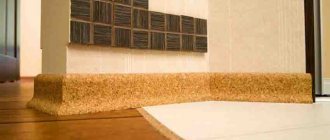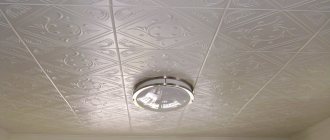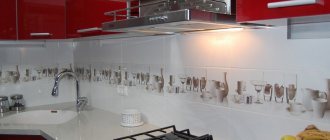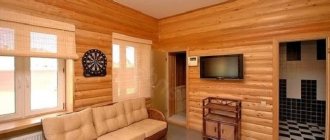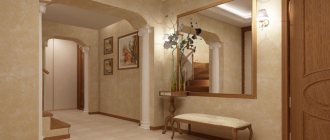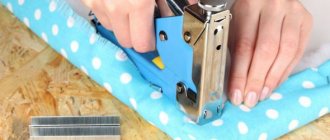25104 0 5
Icer October 22, 2016Specialization: master in the construction of plasterboard structures, finishing work and laying floor coverings. Installation of door and window units, finishing of facades, installation of electrical, plumbing and heating - I can give detailed advice on all types of work.
Drywall is one of the most popular finishing materials today, so the issue of attaching various elements to it is very relevant. There are a lot of fastening options, and today we will look at one of the most popular solutions – Butterfly drywall fasteners.
In the photo: Butterfly fastening for drywall is simple and reliable
When should a butterfly dowel not be used?
Quick response
A butterfly dowel cannot be used if: 1. The depth of the cavity is less than the length of the dowel 2. The space is filled with solid insulation 3. A “protruding nail” is needed
About the depth of the cavity. There should be enough space between the sheet material (plasterboard, MDF, OSB) and the wall. Even if we take into account that when compressed the butterfly does not take up much space, the length of the screw still does not change. Moreover, the self-tapping screw is always longer than the dowel.
You will not be able to use a butterfly if the cavity inside is less than 40mm for two-layer sheathing and less than 55mm for single-layer. I mean a standard 10x50mm butterfly dowel. With other sizes of dowels, you need to consider the permissible minimum depth for each situation.
If the depth of the cavity is less, try using a molly dowel, it is a little shorter and can help you out in this situation, but keep in mind that the molly requires special pliers for installation.
About the insulation. If you have mineral wool inside, it will easily become wrinkled when installing the butterfly. But if it is some kind of polystyrene foam or polystyrene foam, then problems may arise. You can drill through such insulation, but it’s hard to say how the butterfly will open in it. Again, molly may work in this situation as well.
About the "carnation". To hang clocks, mirrors, paintings, bookshelves, most often, you need a self-tapping screw sticking out of the wall. With a regular dowel you can easily leave a small tail in a concrete wall and it will hold tightly, but with a butterfly dowel this is not possible. The butterfly fully opens and has maximum load-bearing capacity only when the self-tapping screw is tightened all the way, close to the wall. Look at the picture to see what is correct and what is not.
How to and how not to attach a butterfly dowel
That is, you must screw the object tightly with a self-tapping screw. If you don't tighten it, but leave the nail, it will all hang out. To hang objects in this way using a butterfly, you need a special self-tapping hook and a half-ring self-tapping screw, always with a limiter. I will show you what they look like below in the chapter on self-tapping screws.
Alternatively, if you are looking for a hook, you may want to consider a "no-drill" fastener. A convenient thing, but it is only suitable for hard walls. Drywall is a fragile material and I would use such fasteners with caution and only for very light objects, maximum a watch, a photograph, a small painting. I definitely wouldn’t hang a mirror or bookshelf on drywall using “no-drill fasteners.”
Other varieties
To attach the chandelier, it is best to use spring-type fasteners. In addition to the spring mechanism, the drywall dowel umbrella uses folding wings and a special metal rod, which powers these wings. Such a dowel is inserted into the hole with pressed petals, which the spring will unfold as soon as the fastener reaches the empty body.
The umbrella dowel has folding wings that open after screwing
Chemical anchors are a special capsule containing an adhesive mixture. The capsule will be crushed and the glue will leak out at a certain moment when such an anchor is attached. A special chemical reaction inside the hole creates a bond that will provide a secure fit.
Butterfly dowel dimensions
Quick response
Butterfly dowels come in diameters from 6mm to 14mm, lengths from 28mm to 60mm. 10x50mm is the most popular and universal size.
Why exactly 10x50mm? Because this size is suitable for both one layer of plasterboard with a thickness of 12.5 mm, and for two layers with a thickness of 25 mm. See how the butterfly design behaves depending on the thickness of the sheet.
Butterfly dowel 10x50mm on different thicknesses of gypsum board sheets
The butterfly dowel has several notches on its “legs” and, depending on the thickness of the sheet, folds differently. This makes the butterfly a versatile drywall anchor.
You can find other sizes of butterflies in stores and construction markets. Here is a complete list of what I was able to find for sale:
- 14x35mm
- 13x32mm
- 10x50mm
- 8x28mm
- 6x40mm
If you are working with drywall, then choose 10x50mm. Other sizes are intended for other sheet thicknesses and other materials and situations.
Types of products
There are several types of fasteners of this type that are used in different situations, the following butterflies for drywall are especially in demand:
Butterfly dowel 8x28
This element is used for fastening small, lightweight structures, and is the smallest. Good quality products are sold everywhere, and the price is no more than 50 kopecks. This element is not used as often as the next one.
Dowel Butterfly 10x50
The most popular fastening option, it is widely used by both private craftsmen and construction companies. The difference between this element and the first is that the spacer elements are much larger - this results in a better quality fastening. In addition, there is a double tongue inside the product, which increases the strength of the screw.
Important! Products can be made from several types of material - polypropylene, nylon, polyethylene. And when choosing, you need to base your choice on the elasticity of the material. Remember, if the dowel is rigid, it will break when screwing in the screw.
These hangers cost 1 ruble apiece, which is inexpensive if you consider that one fastener can withstand a load of 24 kg. If you use two dowels, you can hang cabinets or shelves on them.
Metal dowel Butterfly
This pendant is made of metal and is called “Molly”. It differs from plastic structures not only in material; this fastener has a large size range:
- self-tightening fasteners;
- L-shaped projection design;
- ring-shaped dowels;
- with a hook-shaped protrusion.
Thanks to this, these elements have a very wide range of applications. The metal structure is much stronger than plastic elements; it is similar to an anchor. But do not forget that the strength of plasterboard sheets is much less than the strength of fasteners and metal profiles.
Universal dowel
If we consider the butterfly dowel-nail for drywall, then we should note the universal elements used for both solid products and sheet material.
Manufacturers produce different hangers and dowels depending on the material of manufacture and configuration, but they have one common element - a hole for a self-tapping screw and slots for expansion. The best option is a nylon anchor, as it is the most elastic.
If we consider the sizes, then there are a large number of them, the difference is in diameter and length, so choosing the option that suits you is not difficult. Universal elements are slightly lower in strength than special ones, so if you need to hang a kitchen cabinet on plasterboard, it is better to use a Butterfly dowel nail.
Drill bit for installing a butterfly dowel
Quick response
Use a drill bit the same size as the butterfly dowel or 0.5mm thinner.
Manufacturers recommend drilling holes equal to the diameter of the dowel, but my personal experience says that it is better to take a slightly thinner drill. For example, for a 10x50mm dowel, the drill diameter is 9.5mm, for 8x28mm - 7.5mm.
If you don’t have a 9.5mm or 7.5mm drill at hand, and there may not be any, since the sizes are quite rare, then drill according to the diameter of the dowel. But try not to deviate the drill from the central axis when drilling, so as not to increase the diameter of the hole, because gypsum material is quite soft. Otherwise, the dowel will not fit tightly and may turn when tightening the screw.
Peculiarities
A butterfly dowel is a fairly simple device that is used for attaching cornices, baseboards, brackets, wall cabinets or lamps to a sheet of drywall .
It is a self-tapping screw, complemented by a plastic element that looks like butterfly wings. This is how the fastener got its name. When the dowel is twisted, the “wings” are straightened and pressed tightly against the back surface of the drywall sheet. Due to this, the load on the sheet is distributed more evenly. This significantly reduces the risk of material damage during installation work.
What kind of screw is needed for a butterfly dowel?
Quick response
For a butterfly dowel, a self-tapping screw with a diameter of 3.5 to 4 millimeters is suitable. The length of the screw is from 35 to 60 millimeters.
Diameter. Butterfly dowels are usually equipped with a self-tapping screw of the required size. But sometimes it happens that a standard self-tapping screw does not fit in length. This happens when the thickness of the hung object is more than 5-6mm. For example, you are going to hang a bookshelf with a back wall thickness of 16mm. A standard butterfly screw is unlikely to be enough - you simply won’t be able to reach the thread. In this case, you need to choose a longer screw.
And here, choose only those self-tapping screws whose diameter is strictly within the range of 3.5-4 mm. Otherwise, you will get cranking. With a self-tapping screw diameter of less than 3.5 mm, it will turn in the thread due to weak adhesion, and with a diameter of more than 4 mm, the entire dowel will turn and destroy the hole in the gypsum board.
Form. As for the external shape, depending on the task, 4 types of screws can be used together with the butterfly dowel:
Self-tapping screws for butterfly dowels
A self-tapping screw with a countersunk head, a self-tapping screw with a convex head, a self-tapping hook screw with a limiter, a self-tapping half-ring screw with a limiter. The last two are required with a limiter . They are not so easy to find on sale, but others will not be suitable for a butterfly.
Most popular manufacturers
Among modern manufacturers of fasteners, the following can be distinguished:
- "Mashkrepezh";
- "About Metiz";
- "Weld-Metiz";
- MOLLI.
How to attach a butterfly dowel (photo step by step)
Step 1. Drill a hole with a drill or screwdriver. Drill according to the diameter of the dowel or 0.5 mm less.
Installation of the butterfly dowel, step 1
Step 2. Squeeze the butterfly's "legs" with your fingers into a rod shape.
Installation of the butterfly dowel, step 2
Step 3. Insert into the hole.
Installation of the butterfly dowel, step 3
Step 4. On the back side of the sheet, the butterfly itself will straighten out a little.
Installation of the butterfly dowel, step 4
Step 5. Using gentle, light taps, drive the dowel all the way into the drywall.
Installation of the butterfly dowel, step 5
Step 6. Insert the self-tapping screw into the dowel along with the object being hung.
Installation of the butterfly dowel, step 6
Step 7. Screw the self-tapping screw all the way with a screwdriver.
Installation of the butterfly dowel, step 7
Step 8. As you twist the butterfly, it will straighten out. When using a screwdriver, be careful not to tighten completely. It is better to tighten it with a screwdriver so as not to break the dowel.
Installation of the butterfly dowel, step 8
Step 9. Until it wedges completely. At this point, the screw will begin to tighten tightly. Be careful! Further tightening will result in the dowel turning and damage or destruction of the drywall hole.
Installation of the butterfly dowel, step 9
Step 10: Check the fit. Nothing should be loose.
Installation of the butterfly dowel, step 10
Installation of the butterfly dowel is completed.
Quick fastening with a pulley
The low cost and simplicity of design made the driva very popular. A drywall dowel with a thickness of at least 9 mm is used. With its help, it is good to fasten not very heavy elements. Sometimes it is called “snail”.
The fastening element has the following advantages:
- sparse and high threads allow the drive to be firmly fixed in the hole;
- low cost is achieved due to the simplicity of the design and the use of plastic in the manufacture of the drive;
- The dowel can be screwed into a plasterboard wall without preliminary preparation, thanks to the presence of a sharp tip.
Scheme for screwing in the dowel of the drive
The drive is screwed in using a regular shaped screwdriver. Then you will need to screw a self-tapping screw into the drive, passing it through the element attached to the wall. The self-tapping screw not only secures the structure, but it also pushes apart the pointed part of the tree. Under the pressure of the self-tapping screw, it diverges to the sides and plays the role of an additional support.
Purpose of hardware
A butterfly dowel allows you to securely fasten various elements to a gypsum plasterboard structure. The product consists of two parts - spacer and static. The first is installed in the prepared hole, after which it expands by tightening the threaded element. A special border is provided to prevent hardware from falling into the drywall. This significantly increases the reliability of the fastener.
Tips and tricks
If you have never encountered installation and finishing work, then it is best to entrust this task to professionals. They will get the job done quickly, and you won't have to redo anything. And for those who decide to install the fasteners themselves, it is important to know a few basic points that will significantly affect the efficiency and final result of your work.
- Drive the butterfly dowel with a hammer. It is not enough to simply screw in the anchor, as it may dangle in the hole and not be secured tightly enough.
- Maintain optimal sizes. If you make too large a hole in a sheet of drywall, the fasteners will not hold well and will not bring the necessary benefit.
- Watch the thickness of the sheet. The “butterfly” works great on products whose thickness does not exceed five millimeters. For larger structures, you should select a different fastening element. At a minimum it should be longer.
- Leave enough space behind the gypsum board. Remember that there must be at least thirty-five millimeters of free space behind the sheet of drywall. This is the only way you will be able to optimally tighten the anchor by pressing the stop.
- Use a regular screwdriver. Don’t be lazy and put the powerful drill aside. Since high speeds of the equipment can easily damage the plastic edges of the stop. While a screwdriver will not harm them at all.
Main characteristics
Hardware has the following technical parameters:
- The minimum length of the self-tapping screw is 55 mm.
- Length 50 mm, diameter 10 mm.
- Can be used for drywall, chipboard, gypsum board, the thickness of which does not exceed 12.5 mm.
- The standard working load is 30 kg, the maximum permissible is 70 kg.
- Ribbed parts are provided to prevent spontaneous unwinding during installation.
When correctly calculating the permissible load, it is necessary to use performance indicators. If you need to secure a structure weighing 50 kg, then it is enough to install 2 butterfly dowels (for example, for a shelf). If necessary, another attachment point is added to prevent tearing.
Material of manufacture
Typically, the following materials are used to produce butterfly dowels:
- plastic;
- nylon;
- metal.
Plastic hardware is the most common and inexpensive. They are suitable for mounting structures with low weight. When choosing, be sure to pay attention to the permissible load indicators.
A metal butterfly is much more expensive than other options, but it is more durable. For maximum reliability, the hardware is coated with an anti-corrosion compound.
Diversity in the construction market
To ensure reliable fastening to drywall, it is necessary to use not ordinary self-tapping screws, but special dowels designed for gypsum materials. To figure out which type of fastening is best, let's look at each of the proposed options.
Dowel “Driva”
The main purpose is to attach lamps, wooden slats and other decorative and functional products to plasterboard.
The thickness of the canvas must be at least 9 mm.
- Most often, Driva dowels are made of plastic, but there are also metal ones.
Metal “Driva” - this type does not allow the edges of the dowel to be torn off, reliably fixing the hinged structure
- They are considered the easiest type of fastening for drywall.
- Fixation is carried out due to rare and wide threads. This method prevents the plaster from crumbling, ensuring reliable fixation of the drywall dowel.
- Driva does not require pre-drilling a hole. The dowel can be screwed in using a regular screwdriver or screwdriver.
It cannot be said that such fasteners are the most reliable, but they can be used when hanging any objects, such as photo frames, paintings, sconces and other light decorative items.
Dowel “Umbrella”
Another type of fastening that looks like an umbrella.
It can be used not only for drywall, but also for other materials: chipboard, reinforced hollow slabs.
- If we compare it with other types, it is rightfully considered the most powerful fastener. Therefore, it is more often used for hanging cabinets, water heaters and curtain rods.
- By opening into the void, “the umbrella distributes the entire load over a large area, which does not allow the drywall to experience stress at one point.
- Can be equipped with L-hooks, hooks and eye screws.
Various dowel options available on the market
Note! A butterfly for attaching drywall is not in many ways inferior to an umbrella in terms of reliability, but at the same time it is several times cheaper.
Dowel “umbrella” is more often used for suspended ceilings; for example, this type of fastener can support a heavy chandelier.
“Umbrella”, aka “Molly” - suitable for various designs and materials
Dowel “U”
A type of fastening that is made of polypropylene.
Quite a practical fastener that perfectly fixes light objects on drywall.
Which is better: heated floors or radiators?
Warm floorBatteries
- There can be two options: with a side (thrust washer) and without a side. The only difference is that the presence of a bead prevents the dowel from falling into the material.
- The price is quite reasonable, it is plastic after all.
For your information! This type of dowel is disposable, we do not recommend using it twice. After the self-tapping screw is unscrewed, a thread will appear on the plastic walls, which next time will not fix the hardware so reliably.
Standard polypropylene dowel: at the top - for concrete, at the bottom - for plasterboard
Dowel “Butterfly”
And now we will bring to your attention the butterfly plasterboard dowel, which everyone has probably heard of. This dowel is the most common, since it is used not only by builders, but also by people who have nothing to do with construction.
Its merits will answer the question why is it so popular?
- The thickness of one plastic dowel is 10-12 mm, which is quite enough to withstand several cycles of screwing in and out of self-tapping screws.
- The stop, which is formed on the opposite side of the drywall, distributes the load over a larger area, making the drilling site less vulnerable.
- Longitudinal ribs prevent the dowel from rotating, which increases the service life of drywall fasteners.
Note! The ribs will be saved only if the diameter of the hole is no larger than the thickness of the dowel.
As you can see, the characteristics described above allow us to say that this type of fastening is perfect for working with drywall. You can hang not only lamps and paintings on it, but also attach wall cabinets, TV brackets and much more.
Look at the photo to see how the butterfly dowel behaves in the material.
It can be seen that the stop is quite tight, it allows you to avoid accidental failure of the fastening


